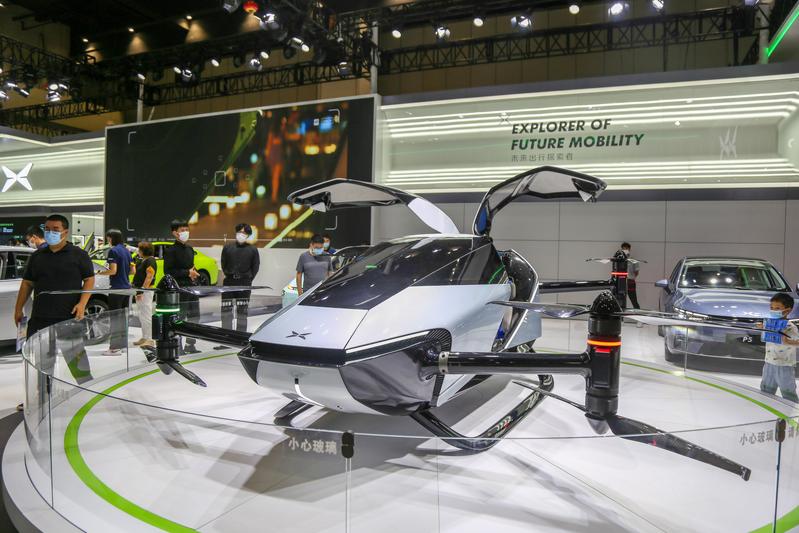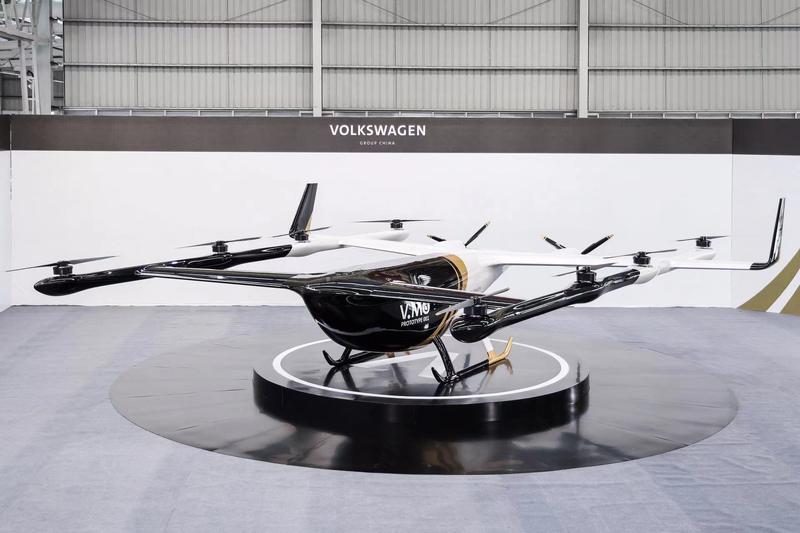Personal mobility concepts include flying vehicles capable of escaping big-city congestion
 Xpeng displays its sixth-generation flying car X2 at the 35th Zhengzhou Dahe International Auto Show in Henan province on July 19. (PHOTO PROVIDED TO CHINA DAILY)
Xpeng displays its sixth-generation flying car X2 at the 35th Zhengzhou Dahe International Auto Show in Henan province on July 19. (PHOTO PROVIDED TO CHINA DAILY)
The sky's the limit for carmakers; many of them are exploring the fast-emerging urban air mobility market, which utilizes airspace for short- and medium-distance connections, especially above and between large cities.
Last week, Volkswagen Group China unveiled its first electric Vertical Take-Off and Landing vehicle prototype, or flying car, as it is commonly called.
The company said this model, based on current autonomous driving solutions and battery technology, is part of its strategy to explore and break new ground in fully electric and sustainable individual mobility concepts.
The model has an x-wing configuration measuring 11.2 meters in length and a width of 10.6 m, powered by eight rotors for vertical lift and two propellers for horizontal flight.
Volkswagen Group China said it will conduct several flight tests later this year to optimize the concept. An improved prototype will undergo further advanced test flights in late summer 2023.
In its final future iteration, the fully electric and automated eVTOL could carry four passengers plus luggage for up to 200 kilometers, said the company.
The company said the vehicle is likely to be first pitched as a premium product for high-net worth and tech-savvy Chinese customers, for example, VIP air shuttle services.
In China, it is set to play a significant role in the future of urban and intercity transport in its congested megacities, said the company.
Volkswagen Group China started the vertical mobility project in 2020, which includes developing the urban air mobility market and the extension of urban traffic into airspace.
Stephan Woellenstein, now the former CEO of Volkswagen Group China, said that this was a pioneering project a young team of Chinese experts started from scratch.
 Volkswagen Group China unveils its first electric Vertical Take-Off and Landing vehicle prototype on July 27. (PHOTO PROVIDED TO CHINA DAILY)
Volkswagen Group China unveils its first electric Vertical Take-Off and Landing vehicle prototype on July 27. (PHOTO PROVIDED TO CHINA DAILY)
He said: "They are working with new design concepts and materials while developing new safety standards, disrupting and innovating every step of the way.
"The launch of this stunning validation model-the V.MO-is the first of many remarkable milestones on our exciting journey toward urban air travel and a perfect example of our 'From China, For China' mission.
"Our long-term aim is to industrialize this concept and, like a 'Flying Tiger', break new ground in this emerging and fast-evolving new mobility market," he added.
China's electric car startup, Xpeng, is exploring the flying car market as well. Its subsidiary, HT Aero, is scheduled to launch its first model in 2024.
Last week, its first production plant for flying cars opened in Guangzhou, capital of South China's Guangdong province.
Covering 35,000 square meters, it includes two production workshops as well as a testing center.
Volvo-owner Geely was one of the first carmakers to enter the flying vehicle sector. In 2021, it teamed up with German company Volocopter, a specialist in the manufacture of autonomous air vehicles, to establish a joint venture in Chengdu, capital of Southwest China's Sichuan province.
The joint venture will take charge of production and market operations of Volocopter products in the Chinese market.
It plans to help promote urban air mobility in China over the next three to five years. The joint venture also signed orders with Volocopter for 150 aircraft, including logistical unmanned aerial vehicles and manned aircraft.
The emerging flying vehicles sector is now viewed as a serious solution to urban traffic congestion and a new alternative to personal mobility in cities, said global financial services company Morgan Stanley.
It estimates the sector will grow into a market worth $1 trillion by 2040 and $9 trillion by 2050.
Global consultancy Roland Berger estimates there will be up to 160,000 flying vehicles operating as air taxis by 2050.
It said there will primarily be three types of flying vehicles: city taxis with a range of 15-50 km catering to inner-city transportation needs; airport shuttles with the same range to take travelers to and from airports; and intercity jets covering distances of up to 250 km that will provide services between major urban destinations.
Manfred Hader, a Roland Berger senior partner, said: "By 2050, airport shuttles and intercity services together will take the lion's share of the market, achieving about 90 percent of revenue."


